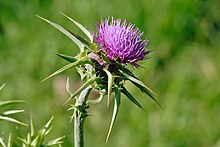

Thistle is the common name of a group of flowering plants characterized by leaves with sharp prickles on the margins, mostly in the family Asteraceae. Prickles can also occur all over the plant – on the stem and on the flat parts of the leaves. These prickles protect the plant from herbivores. Typically, an involucre with a clasping shape similar to a cup or urn subtends each of a thistle's flower heads. The typically feathery pappus of a ripe thistle flower is known as thistle-down.[1]
The spininess varies considerably by species. For example, Cirsium heterophyllum has very soft spines while Cirsium spinosissimum is the opposite.[2] Typically, species adapted to dry environments are more spiny.
The term thistle is sometimes taken to mean precisely those plants in the tribe Cardueae (synonym: Cynareae),[3] especially the genera Carduus, Cirsium, and Onopordum.[4] However, plants outside this tribe are sometimes also called thistles.
Biennial thistles are particularly noteworthy for their high wildlife value, producing copious floral resources for pollinators, nourishing seeds for birds like the goldfinch, foliage for butterfly larvae, and down for the lining of birds' nests.[5][6][7]
A thistle is the floral emblem of Scotland and Lorraine, as well as the emblem of the Encyclopædia Britannica.
- ^ "Definition of THISTLEDOWN". www.merriam-webster.com. Retrieved 28 September 2023.
- ^ "Melancholy Thistle". NatureGate. Retrieved 27 November 2019.
- ^ "Cardueae". Tree of Life webproject. Retrieved 30 October 2012.
- ^ "Thistle". Merriam-Webster's online dictionary. Retrieved 30 November 2007.
- ^ Hicks, DM; Ouvrard, P; Baldock, KCR (2016). "Food for Pollinators: Quantifying the Nectar and Pollen Resources of Urban Flower Meadows". PLOS ONE. 11 (6): e0158117. Bibcode:2016PLoSO..1158117H. doi:10.1371/journal.pone.0158117. PMC 4920406. PMID 27341588.
- ^ Eckberg, James; Lee-Mäder, Eric; Hopwood, Jennifer; Foltz Jordan, Sarah; Borders, Brianna (2017). "Native Thistles: A Conservation Practitioner's Guide". The Xerces Society. Retrieved 27 August 2018.
- ^ "Which flowers are the best source of nectar?". Conservation Grade. 15 October 2014. Archived from the original on 14 December 2019. Retrieved 18 October 2017.